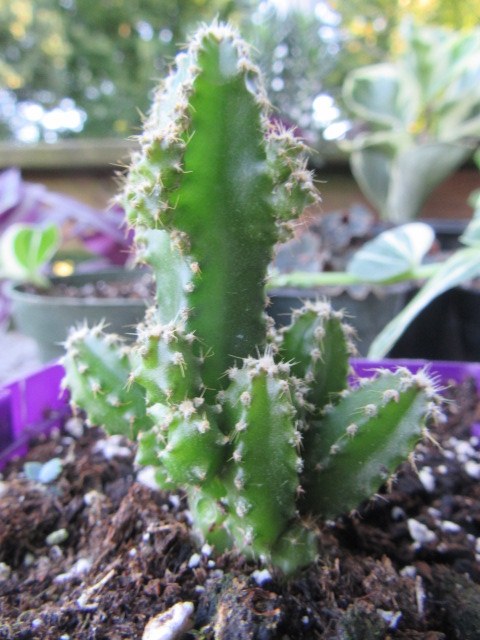
Acanthocereus tetragonus (‘Fairytale Castle’) on 9-13-18, #507-1.
Green Finger, Fairytale Castle, Fairy Castles, Barbed Wire Cactus, Etc.
Acanthocereus tetragonus ‘Fairytale Castle’
a-kan-tho-KER(SER)-ee-us tet-ra-GON-us
Synonyms of Acanthocereus tetragonus (36) (Updated on 12-6-23 from Plants of the World Online): Acanthocereus baxaniensis (Karw. ex Pfeiff.) Borg (1937), Acanthocereus colombianus Britton & Rose (1920), Acanthocereus floridanus Small ex Britton & Rose (1923), Acanthocereus horridusBritton & Rose (1920), Acanthocereus occidentalis Britton & Rose (1920), Acanthocereus pentagonus (L.) Britton & Rose (1909), Acanthocereus pitajaya (DC.) Dugand ex Croizat (1943), Acanthocereus princeps (Pfeiff.) Backeb. (1963), Acanthocereus subinermis Britton & Rose (1920), Acanthocereus tetragonus var. micracanthus Dugand (1966), Cactus pentagonus L. (1753), Cactus pitajaya Jacq. (1763)(nom. illeg.), Cactus prismaticus Willd. (1814), Cactus reptans Salm-Dyck ex DC. (1828), Cactus tetragonus L. (1753), Cereus baxaniensis Karw. ex Pfeiff. (1837), Cereus baxaniensis f. pellucidus (Otto) Schelle (1926), Cereus baxaniensis var. ramosus Salm-Dyck ex Walp. (1843), Cereus dussii K.Schum. (1897)(nom. illeg.), Cereus horribilis A.Berger (1929), Cereus nitidus Salm-Dyck (1850), Cereus pentagonus (L.) Haw. (1812), Cereus pitajaya DC. (1828), Cereus pitajaya var. variabilis Weing. (1906), Cereus princeps Pfeiff. (1837), Cereus prismaticus (Willd.) Haw. ex Steud. (1840)(nom. illeg.), Cereus ramosus Karw. ex Pfeiff. (1837), Cereus reptans Haw. ex Steud. (1840)(not validly publ.)Cereus tetragonus (L.) Mill. (1768), Cereus tetragonus var. major Salm-Dyck ex Walp. (1843), Cereus tetragonus var. minor Salm-Dyck (1834), Cereus tetragonus var. ramosior Link & Otto (1830), Cereus undulatus Pfeiff. (1837), Cereus variabilis Engelm. (1856)(nom. illeg.), Cereus vasmerii Young (1873)
Not to be confused with Cereus hildmannianus subsp. uruguayanus ‘Fairy Castle’. They are two separate monstrose forms of two species with similar characteristics. I have both and I can see there are differences (but sometimes I wonder…).
Acanthocereus tetragonus (L.) Hummelinck is the accepted scientific name for this species of cacti. It was described by Pieter Wagenaar Hummelinck in Succulenta (Netherlands) in 1938. The species was first named and described as Cactus tetragonus by Carl von Linnaeus in the first edition of Species Plantarum in 1753.
The genus, Acanthocereus (Engelm. ex A.Berger) Britton & Rose was named and described as such by Nathaniel Lord Britton and Joseph Nelson Rose in Contributions from the United States National Herbarium in 1909. Georg (George) Engelmann and Alwin Berger previously named the genus in 1905 but put it in a subsection of Cereus. Actually, Engelmann probably named it at a previous date then Berger published the name with Engelmann’s description in the Annual Report of the Missouri Botanical Garden in 1905.
As of 12-6-23 when this page was last updated, Plants of the World Online by Kew lists 16 species of Acanthocereus. It is a member of the plant family Cactaceae with 150 genera. Those numbers could change as updates are made on POWO.
There is a little confusion between Acanthocereus tetragonus and Cereus hildmannianus subsp. uruguayanus. When I first bought my Cereus hildmannianus subsp. uruguayanus it was unlabeled. I posted photos of it on a Facebook group and was told it was Cereus hildmannianus subsp. uruguayanus and they said the common name was Fairy Castles. Then, when I was doing research on the Acanthocereus tetragonus, I found one of its common names is Fairytale Castle… I am no cactus expert, but I do like correct information to pass on. If I am confused, then the information I pass on is also confusing. One of their pages about Cereus hildmannianus subsp. uruguayanus has photos of Acanthocereus tetragonus… Well, there are several websites that have photos of one with the name of the other. But, from experience having both, they look different. Both species in the wild grow very tall, but they apparently both have “miniature versions” or cultivars which is where the name Fairy Castles and Fairytale Castles comes from. These miniature versions appear to be monstrous forms.
THERE ARE SEVERAL LINKS AND GROWING RECOMMENDATIONS AT THE BOTTOM OF THE PAGE FOR FURTHER READING.
The LLIFLE (Encyclopedia of Living Forms) says this in the description of Acanthocereus tetragonus cv. Fairytale Castle:
“Fairytale castle”, “Fairy Castle” or “Green finger” cactus is the evocative name by which this common succulent plant is marketed and refers to the numerous vertical stems of different heights that resemble spires and turrets. This diminutive cultivar ‘Fairy Castle’ was discovered in cultivation and is a very popular plant often found in the succulent part of the box retail stores. Some experts classify the cactus as a monstrous form of Acanthocereus tetragonus (Acanthocereus floridianus), but the true self of this plant is controversial and some suggest that it may be a form of Cereus hildmannianus or even a dwarf form of Cereus hildmannianus subs. uruguayanus. Whichever scientific name is correct, the plant is a delightful cactus.”
I picked this Acanthocereus tetragonus up at Wagler’s Greenhouse in September 2018. I think I had one of these in 2015, which I think also came from Wagler’s which was also unnamed. I gave up most of my plants a few years ago, so out it went. So, I decided to bring this one home.
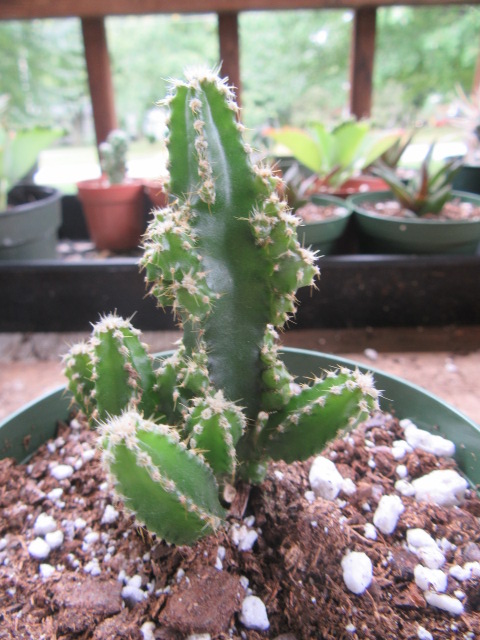
Acanthocereus tetragonus (Fairytale Castle) on 10-10-18, #519-1.
I always measure the cactus when I bring them inside for the winter. So, on October 10 (2018) this plant measured 3″ tall x 2″ wide.
One website says their Acanthocereus tetragonus ‘Fairy Castles’ is 10 years old and it has only grown to 18″.
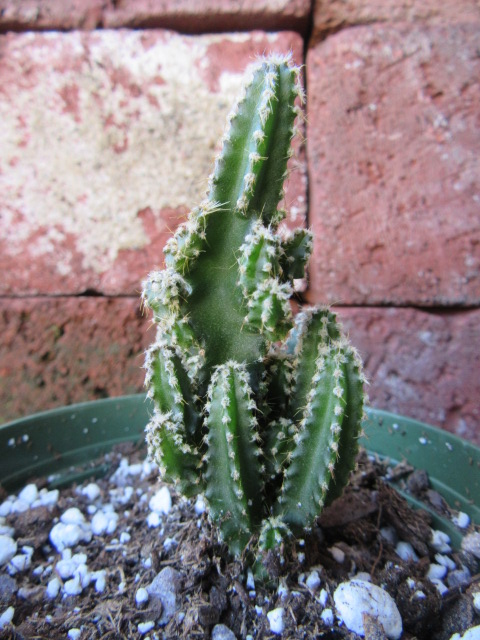
Acanthocereus tetragonus on 11-29-18, #534-1.
We had a couple of warm days so I took the cactus outside for a photoshoot on November 29
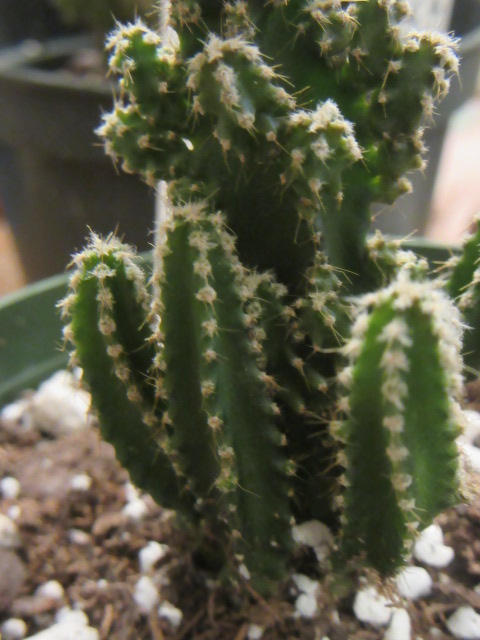
Acanthocereus tetragonus close-up on 12-1-18, #535-1.
Acanthocereus tetragonus is a ribbed, five-sided, columnar growing cactus. The areoles produce short hair-like spines with small tufts of wool.
<<<<2019>>>>

Acanthocereus tetragonus on 6-22-19, #593-1.
We made it through the winter and the potted plants have been enjoying the outdoors since about May.

Acanthocereus tetragonus at 4 1/2″ tall x 2 7/8″ wide on 10-11-19, #639-2.
I had to move the potted plants inside on October 11 because the forecast was calling for a “widespread frost”. As always, I photographed all the potted plants one last time outside and measured the cactus and most of the succulents. The Acanthocereus tetragonus measured 4 1/2″ tall x 2 7/8″ wide. It was 3″ tall x 2″ wide last October 10. That’s pretty good and the offsets grew A LOT. The plant has been in full sun on the back porch all summer which is why it looks like it does. If it were in more shade it may not have changed color…
<<<<2020>>>>

Acanthocereus tetragonus (Fairytale Cactus) at 4 3/4″ tall x 2 3/4″ wide on 10-15-20, #747-1.
The Acanthocereus tetragonus spent 2020 on the front porch with most of the succulents. It wasn’t in full sun in 2020 so it greened up a bit instead of getting a suntan. I had to bring the potted plants inside for the winter on October 15 because an “F” was in the forecast. As always, I measured and photographed the cactus and some of the succulents. The Acanthocereus tetragonus measured 4 3/4″ tall x 2 3/4″ wide so it did grow a little.
<<<<2021>>>>
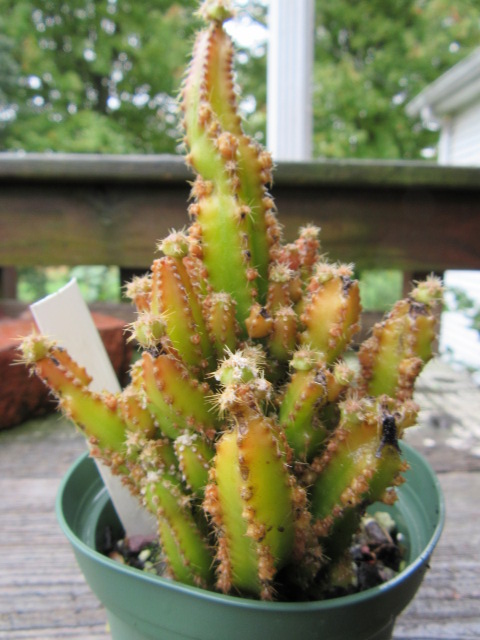
Acanthocereus tetragonus (Fairytale Cactus) at 5″ tall x 2 3/4″ wide on 10-28-21, #853-1.
The Acanthocereus tetragonus did very well over the summer and grew to 5″ tall and is still 2 3/4″ wide. It probably would have grown taller but apparently, the top of the tallest stem broke off… Even at that, it is 3/4″ taller than when it was last measured on October 15 in 2020.
Unfortunately, this plant didn’t make it over the winter…
USEFUL INFORMATION:
Family: Cactaceae
Origin: The species is native to Florida & Texas in the United States, Mexico, northern South America, Panama…
Zones: USDA Zones 10-11 (30-40° F) (possibly to 9a)
Size: Ummm… The species can grow quite tall in the wild, but this monstruosus cultivar remains much smaller.
Light: Sun to part shade
Soil: Well-draining soil. Potting soil amended pumice or perlite and grit.
Water: Average water needs during the growing season, barely in winter.
During the summer, I keep most of my cactus on the back deck where they receive full sun. During the winter most cactus aren’t picky about the light because they are basically dormant. For several winters, mine were in front of the east-facing sliding door in the dining room so they didn’t get much light but they did great. I built a new shelf for the bedroom so now they are in front of a west-facing window. Most of the succulents are on a shelf in a south-facing window in a cool bedroom but a few are in my bedroom.
You can read my Cactus Talk & Update and Cactus & Succulent Tips to get my opinion about growing cactus and succulents.
When you bring your new plants home from the store, you need to check their roots and the soil to see if they are wet. If so, you may want to re-pot it right away. It is advisable to re-pot them in a better potting soil more suitable for cactus and succulents. If they have been grown in plugs, I always remove the plug wrapper.
I hope you enjoyed this page and maybe found it useful. If you have any comments, questions, or suggestions, I would like to hear from you. Please click on “like” if you visited this page. It helps us bloggers stay motivated. 🙂 You can check out the links below for further reading. The links take you directly to the genus and species of this plant. Some sites may use previously accepted names such as Cereus tetragonus.
I just bought a succulent and the plant guide tells me it is a triangle cactus. So I am collecting info, trying to verify if the plant guide was correct. I enjoyed your post and found it helpful. Thank you
LikeLiked by 1 person
Hello April! I am glad you brought home a Triangle Cactus. They are pretty neat and I enjoy having one in my collection. I wish you great success with your new companion. Thank you for visiting and thanks for the comment!
LikeLike
this specific cactus grows lots of pups along the spine, commonly? i just learned about witches broom and i am SO paranoid right now that my fairy cactus has it. it looks like this picture, though.
LikeLiked by 1 person
Hello Cahomaps! It does produce a lot of offsets along the ribs. The only issue I have with this cactus is it not being nice and green like it was when I brought it home. Wagler’s, where I brought the plant home from, has a HUGE specimen that is always nice and green because it stays in the greenhouse. I had mealybugs on this cactus and a few others over the winter. I had never heard of Witches Broom until you mentioned it so I checked it out. Sounds like if your plant has it, it would have an outcrop of offsets beyond what is normal. GEEZ! Keep me posted. Take care and thanks for the comment!
LikeLike